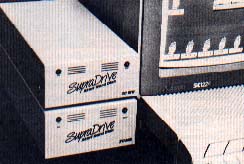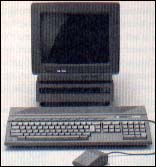GETTING STARTED
A Primer On Hard Drives, Part I
By Scot TumIin
In this issue's "Getting Started" column we begin a discussion of hard disk drives--at present, the most economical way to get massive amounts of data into and out of your ST.
A hard disk drive, like a floppy disk drive, is simply a data storage device. The main purpose for a drive of any kind is to store your programs and data when your computer is turned off. A computer without some form of data storage is little more than an expensive doorstop!
SIMILARITIES AND DIFFERENCES
Last issue we discussed the different kinds of floppy dnves; this issue, let's talk about the similarities and differences between floppies and hard drives. With both hard and floppy drives, a reading and writing device (called a "head'') moves over a spinning disk, in much the same way that a phonograph needle moves over a record. Both the phonograph needle and the floppy disk heads make physical contact with their respective disks to read in information. The floppy disk drive also does something a phonograph can't, however: it writes (stores) information on the disk.
 |
This is the original style of hard drive--the "shoe-box" design. |
A hard drive, on the other hand, operates more like a laser disk player than a phonograph. In a laser disk player, a laser beam "scans" the digital information stored on the disk without making any other physical contact. On a hard drive, the read/write heads do not--must not--make contact with the magnetic surface. The distance between each hard drive head and the disk surface is less than the thickness of a human hair. For this reason, hard drives are inherently more fragile than floppy disk dnves; a single bump while the heads are over the magnetic surface and you may have a "head crash." If the heads do crash into the surface, you can lose not only your data, but also the cost of rebuilding your hard drive!
Inside its protective cover, a floppy disk is made of very thin "floppy" plastic with a magnetic compound bonded to it, while a hard drive has a rigid or "hard" platter coated with a special magnetic compound. Data is stored much more densely on a hard drive than on a floppy disk, thus allowing great amounts of storage in a small space. Drive manufacturers also stack platters on a single spindle within a hard drive to further multiply storage.
But the most obvious difference between hard and floppy drives, of course, is that you can take your information out of your floppy drive and walk off with it--just toss the floppy disk into your briefcase or shove it into your shirt pocket. Most hard drives' plasters are not removable--you set up your hard drive next to your computer and it stays there. However, there are hard drives with their platters in removable cartridges and even a floppy disk drive that holds as much data as most older hard drives. Both of these units combine the flexibility of a floppy disk drive with the vast storage space of a hard drive. (And when erasable optical drives become readily available, you can have it all ten times over--but that's another story.)
Another difference between hard and floppy disks is the number of read/write heads. A single-sided floppy disk drive has one read/write head, while a double-sided disk drive has two. A hard drive has two heads for each platter, one for each side. Between the high density data storage and the high platter speed, a hard drive can locate a file within milliseconds. On a standard floppy disk, it can take several seconds to load a large file (say, 200-300K). But on a hard drive, you can load or save an entire megabyte in a few seconds!
And finally, one of the main advantages that a hard drive has over a floppy drive, besides the vast storage space and quick file access, is its ability to be partitioned, or divided so that it looks to your ST like several smaller drives. We'll talk about partitioning next issue, when we discuss formatting your hard drive.
SELECTING A HARD DISK
Now that you know how a hard drive functions, let's talk about selecting one.
There are a number of factors you should consider before you purchase a hard drive. The most important factor is the amount of storage space you require. A few years back, a ten-megabyte hard drive handled most requirements, but as computers became more powerful, they--and their users--demanded more and more memory, both inside the computer for processing and outside in the form of disk storage. Today, most ST hard drives are at least 20 megabytes, and from there you go straight up. There are hard drives in various configurations--60-,80- and 120-megabyte for instance--and even 160-megabyte drives are not uncommon. If you need lots of storage, you can even buy a one-gigabyte hard drive. That's 1,000 megabytes of storage in a single unit!
The amount of storage space you require depends on what you want to store on your hard drive. If you want to store a typical collection of applications, games, text files and the like, a 20megabyte hard drive is probably large enough for your needs. But if you want to store a huge database or very large animation files, for example, then even 20 megabytes might not be enough. The best advice is to buy the largest hard drive you can afford. You'll be glad you did later.
 |
| The ICD F-50A (50 megabytes). |
ADDING MORE HARD DISKS
Once you've determined the size you need, you should consider other factors. First, is it expandable?
The STs and Megas have only one DMA (Direct Memory Access) port. That's the high-speed input/output "door" that your hard drive needs for its high speed operation. When Atari introduced the SLM804 Laser Printer, it was designed to use the DMA port also. Therefore, in order to use both the SLM804 and a hard drive, you have to connect them in a "daisy chain," which simply means linking them in series, one after the other. Atari's laser printer comes with the SLMC804 interface box that has an additional DMA port built in. You just connect your hard drive to this port and then you can use both the drive and printer. But don't turn off the printer while you're using your hard drive; unfortunately, it turns off the interface box as well.
You can also use the daisy chain method to add multiple hard drives to your ST system. Some recent models of hard drives have an additional DMA port through which you can connect a second hard drive. If you purchase a hard drive with this feature, you'll never run out of storage space--just stack them up and go to town!
A second method of adding more storage space is to remove your hard drive's cover and install another hard drive mechanism inside the chassis. You can get inexpensive hard drive mechanisms through many computer mail order companies; the mechanisms themselves are relatively inexpensive when compared to the price of a complete ST drive system with case, power supply, hard drive controller card and ST-interface card. But be forewarned: this is a tricky hardware modification and should be done only by someone with the proper experience. There are some hardware kits on the market for this purpose, but opening up your hard drive before the end of your warranty period will void the warranty, so unless you or a close friend are good with electronics, don't do it. (Editor's note: In the Winter 1987 issue of START, Dave Small published "Megabytes, Not Megabucks," a how-to article on adding an additional hard disk drive mechanism to your existing ST hard drive,for the adventurous among you.)
OTHER CONSIDERATIONS
Storage space and expandability are very important considerations in your decision to buy a hard drive. However, there are other factors you should consider.
For instance, don't overlook the drive's overall size, or "footprint." How much space do you have on your computer desk or table?
The length of the connecting cable is also important to consider and you might have to do some shuffling of your desk debris to get your drive to fit. Also, timing is critical with hard drives and since cable lengths play a significant role in the timing, don't plan on just buying an extension cable; it may work, but, then again, it may not. If you have to adjust your drive to an awkward position in order to keep its cooling vents clear or move your monitor to a neck-wrenching, eye-straining position, then you might have to redesign your work area. Still another consideration is the noise made by the hard drive's cooling fan.
All in all, the best method for selecting a hard drive is to go to your local computer dealer and examine the display units for yourself. Ask questions, look at the different hard drives, listen to them and ask for a demo. (Editor's note: For further information, see the Hard Drive Overview in the Fall, 1987 issue of START.)
Next issue, we'll take a look at how to format, partition and install your new hard drive.
Scot Tumlin is in charge of Direct Mail Services and Software Technical Support for Antic Publishing.
ST HARD DRIVE MANUFACTURERS
Below are the top manufacturers of hard drives for the ST. Your local computer store should have them in stock or can order them for you. Or if you want, you can order drives directly from the companies listed here (And tell them that START sent you.)
Astra Systems, Inc., 2500 South Fairview, Unit L, Santa Ana, CA 92704, (714) 549-2141.
Atari Corp., 1196 Borregas Ave., P.O. Box 3427, Sunnyvale, CA 94088-3427, (408) 745-2000.
ICD, 1220 Rock Street, Rockford, IL 61101-1437, (815) 968-2228.
Megabyte Computers, 109 W. Bay Area Blvd., Webster, TX 77598, (713) 338-2231; (800) 255-5786.
Supra Corp., 1133 Commercial Way, Albany, OR 97321, (503) 967-9075.